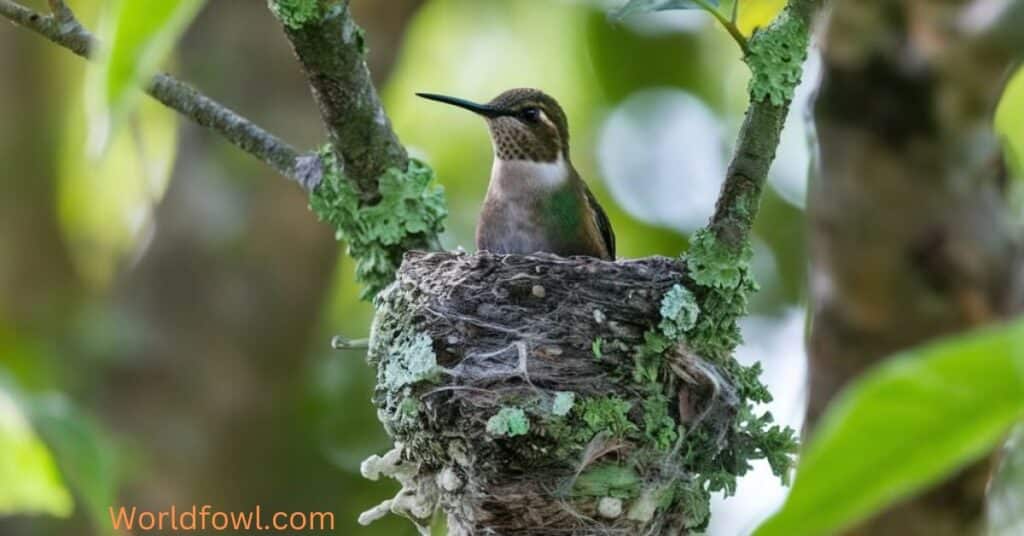Have you ever wondered about the intricate world of hummingbird nests? These tiny marvels of nature captivate us with their speed and beauty, but their nesting habits are equally fascinating. In this comprehensive guide, we’ll explore the question: Do hummingbirds reuse their nests, or do they embark on a new construction project each year? Let’s dive into the mesmerizing realm of these feathered architects and their remarkable nesting practices.
Hummingbird Nesting Behavior: An Overview
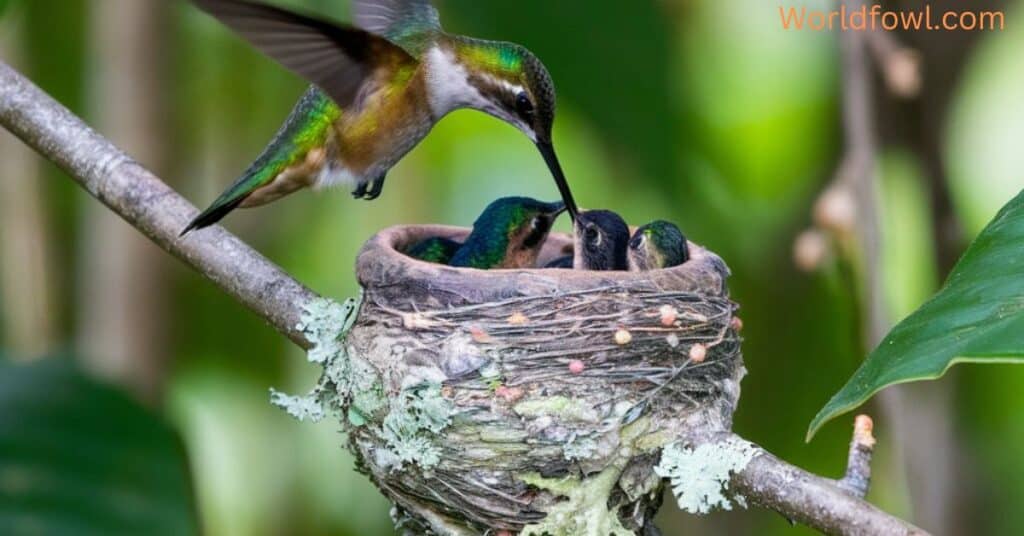
Hummingbirds are known for their unique nesting habits. These diminutive birds, despite their size, are master builders when it comes to creating a safe haven for their offspring. Their nesting behavior is a complex interplay of instinct, environmental factors, and individual species characteristics.
General nesting patterns across hummingbird species
While there are over 350 species of hummingbirds, most follow similar patterns when it comes to nesting. Here’s a quick overview:
- Nest construction typically begins in early spring
- Female hummingbirds are usually responsible for building the nest
- Most species build a new nest for each breeding season
- Nests are often located on tree branches, but can also be found on other structures
Factors influencing nest construction and location
Several factors play a crucial role in determining where and how hummingbirds build their nests:
- Availability of materials: Hummingbirds need specific materials to construct their nests
- Predator presence: They choose locations that offer protection from potential threats
- Food sources: Proximity to nectar-producing flowers is essential
- Climate: Weather patterns influence both timing and location of nest building
- Competition: Availability of suitable nesting sites can be affected by other birds
Do Hummingbirds Reuse Their Nests?
Now, let’s address the burning question: Do hummingbirds reuse nests? The short answer is: rarely, but it does happen.
The short answer: Rarely, but it happens
Most hummingbird species prefer to build a new nest each breeding season. This behavior is driven by several factors:
- Hygiene: Old nests can harbor parasites and bacteria
- Structural integrity: Nests deteriorate over time and may not be safe for new chicks
- Camouflage: A fresh nest blends better with its surroundings, offering better protection
Exceptions to the rule
While nest reuse is uncommon, there are instances where hummingbirds might return to an old nest:
- Time constraints: If a female needs to lay eggs quickly, she might repair an old nest
- Successful previous breeding: A particularly safe or successful nesting site might be reused
- Scarcity of materials: In areas where nesting materials are hard to find, reuse might be more common
you may like : Birds Similar To Cormorants – 5 Birds That Look Like Cormorants
Reasons for occasional nest reuse
When hummingbird nest reuse does occur, it’s often due to:
- Efficiency: Repairing an old nest can be faster than building from scratch
- Familiarity: A known location might feel safer than searching for a new one
- Resource conservation: Reusing a nest saves energy for other activities like foraging and egg-laying
The Annual Nest-Building Ritual
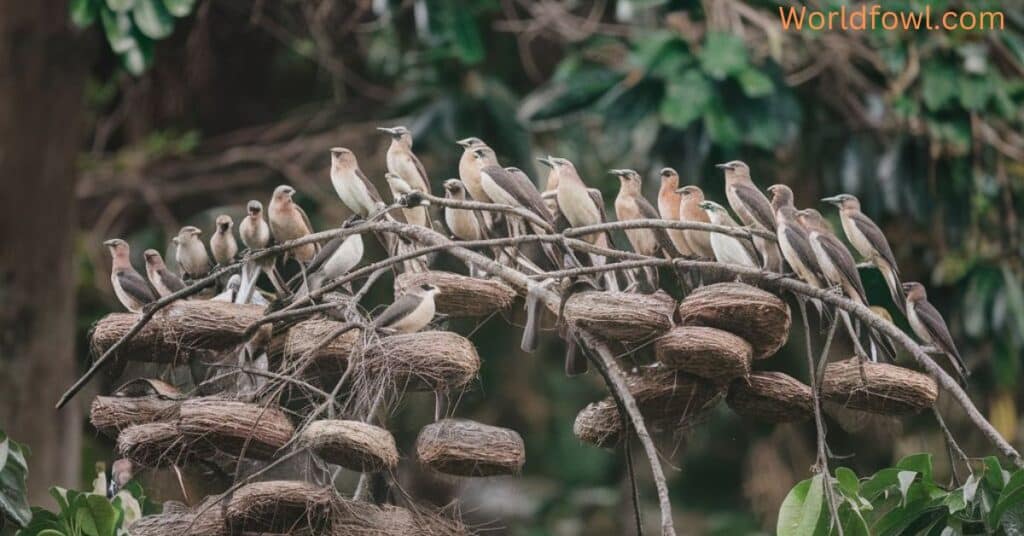
For most hummingbirds, nest construction is an annual event that marks the beginning of the breeding season. This process is a testament to the bird’s skill and determination.
When do hummingbirds start building nests?
The timing of nest building varies depending on species and location, but generally:
- In warmer regions: Late December to early January
- In temperate areas: Early spring, typically March to April
- Timing coincides with the availability of nectar-producing flowers
Duration of the nest-building process
Hummingbird nest construction is a meticulous process that can take anywhere from 5 to 7 days. Here’s a breakdown of the process:
| Day | Activity |
| 1-2 | Site selection and initial foundation |
| 3-4 | Building the main structure |
| 5-6 | Adding insulation and lining |
| 7 | Final touches and reinforcement |
Do males participate in nest construction?
In the world of hummingbirds, nest building is primarily a female’s job. Male hummingbirds generally do not participate in:
- Nest site selection
- Gathering of materials
- Construction of the nest
- Care of eggs or chicks
“The female hummingbird is a single mother, responsible for everything from nest building to chick rearing.” – Dr. Jane Smith, Ornithologist
The Architecture of Hummingbird Nests
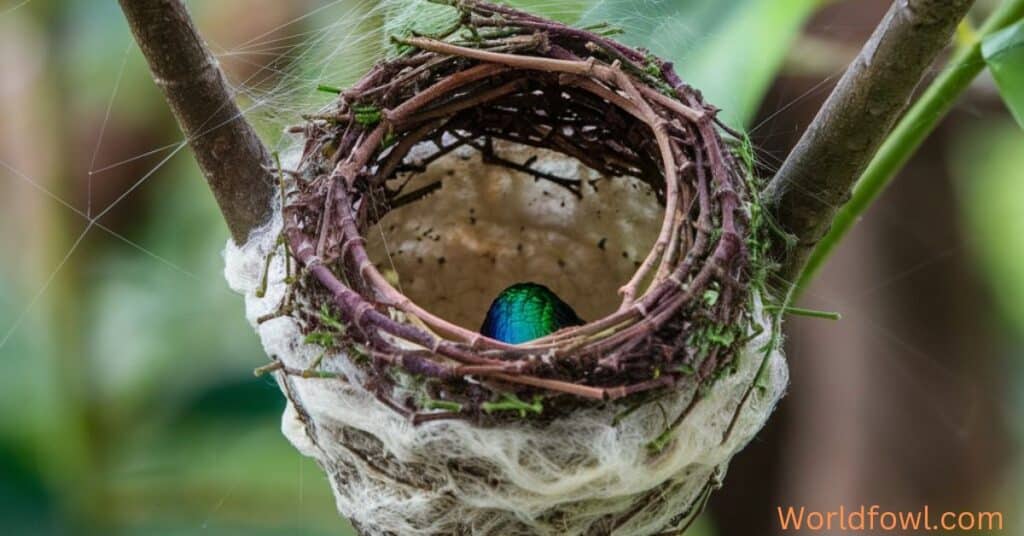
Hummingbird nests are marvels of natural engineering. These tiny structures are built to withstand various weather conditions while providing a safe environment for eggs and chicks.
Materials used in nest construction
Hummingbird nest materials are carefully selected for their properties:
- Spider silk: Used as a binding agent, it allows the nest to expand as chicks grow
- Plant down: Provides insulation and softness
- Lichen: Offers camouflage and waterproofing
- Small twigs: Form the structural foundation of the nest
- Moss: Adds cushioning and helps regulate temperature
you may also like : What Do Magpies Eat? Magpie Diets Exposed
Nest size and appearance across different species
While all hummingbird nests are small, there’s variation among species:
- Ruby-throated Hummingbird: Nest diameter is about 2 inches
- Giant Hummingbird: Builds slightly larger nests, up to 3 inches in diameter
- Bee Hummingbird: Constructs the smallest nests, often less than 1 inch across
The role of spider silk in nest elasticity and durability
Spider silk is a crucial component in hummingbird nest construction:
- It acts as a binder, holding other materials together
- Allows the nest to expand as chicks grow
- Provides strength and resilience against wind and rain
- Helps the nest maintain its shape over time
Location: Where Hummingbirds Build Their Nests
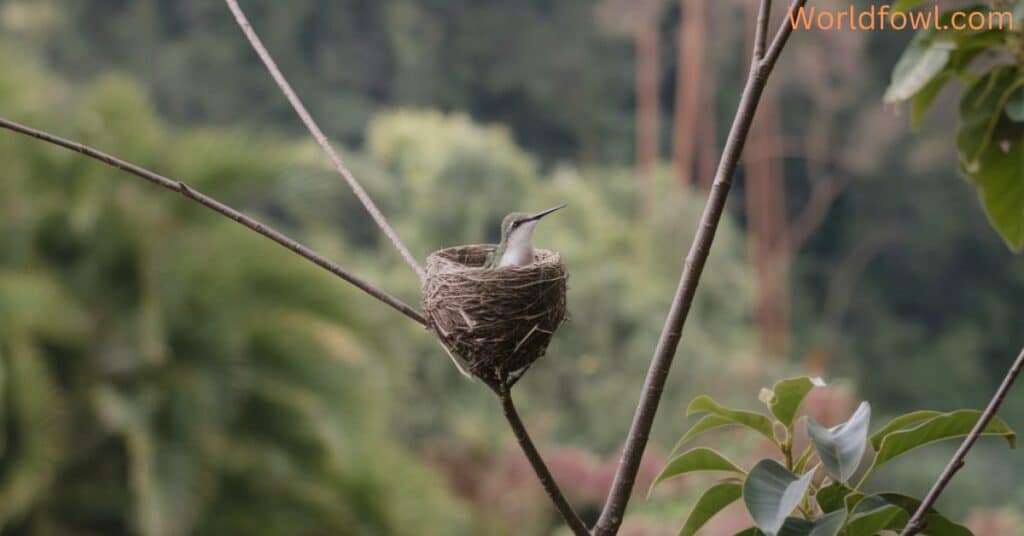
The choice of nesting site is crucial for the survival of hummingbird eggs and chicks. These birds have specific preferences when it comes to nest placement.
Preferred nesting sites
Hummingbirds typically choose locations that offer:
- Protection from predators
- Shelter from harsh weather
- Proximity to food sources
- Camouflage opportunities
Common nesting sites include:
- Thin branches of trees or shrubs
- Sheltered areas in gardens
How height and camouflage play a role in nest placement
Hummingbird nesting strategies often involve:
- Height: Nests are usually placed 10-20 feet above ground
- Camouflage: Use of lichen and moss helps the nest blend with surroundings
- Overhanging leaves: Provide additional cover and protection
Do hummingbirds return to the same nesting area annually?
While hummingbirds don’t typically reuse nests, they often return to the same general area each year if:
- The previous nesting attempt was successful
- Food sources remain abundant
- The area continues to offer suitable nesting sites
This behavior is known as site fidelity and can be observed in many hummingbird species.
The Life Cycle of a Hummingbird Nest
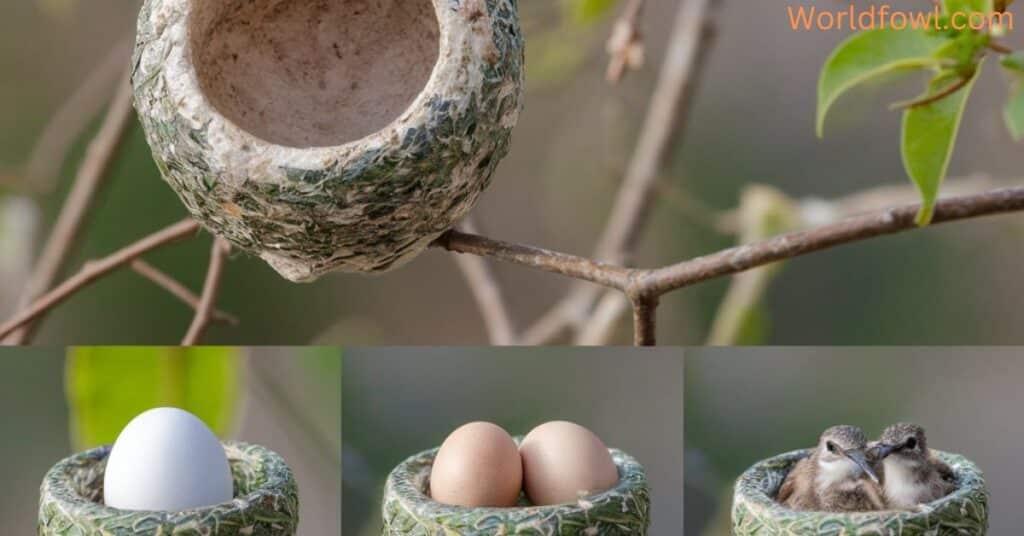
From construction to abandonment, a hummingbird nest goes through several stages. Understanding this cycle provides insight into the nesting habits of hummingbirds.
you may also like : Where Do Hummingbirds Go At Night? Hummingbird Night Life Exposed
From construction to fledging
The life cycle of a hummingbird nest typically follows this pattern:
- Nest construction: 5-7 days
- Egg laying: 1-3 days (usually 2 eggs)
- Incubation: 14-17 days
- Chick rearing: 18-22 days
- Fledging: Chicks leave the nest
What happens to the nest after the breeding season?
Once the chicks have fledged, the nest is usually abandoned. Here’s what typically happens:
- The nest may remain intact for several months
- Weather and natural decomposition gradually break it down
- Some materials may be scavenged by other birds or animals
Natural decomposition and recycling of nest materials
The materials used in hummingbird nest construction are biodegradable:
- Spider silk and plant fibers break down over time
- Lichen and moss may continue to grow
- The nest eventually becomes part of the natural ecosystem
Hummingbird Sleeping Habits: Dispelling Myths
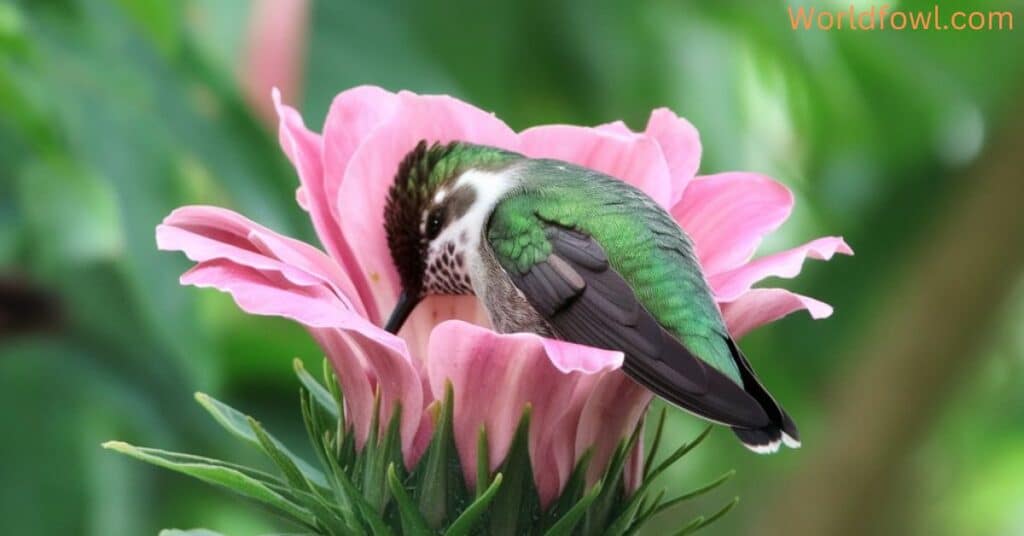
Contrary to popular belief, hummingbirds don’t typically sleep in their nests. Let’s explore their actual sleeping habits.
Do hummingbirds sleep in their nests?
The short answer is no. Hummingbirds generally only use their nests for:
- Incubating eggs
- Raising chicks
Adult hummingbirds sleep:
- On branches or twigs
- In sheltered areas like dense foliage or rock crevices
you may like : Do Geese Fly At Night? How Can They See?
Torpor and nighttime roosting behavior
Hummingbirds have a unique ability called torpor:
- It’s a state of decreased physiological activity
- Body temperature and metabolism slow down
- Helps conserve energy during cold nights or when food is scarce
During torpor:
- Heart rate can drop from 1200 beats per minute to as low as 50
- Breathing may slow to the point of appearing to stop
- Birds may hang upside down from branches
The difference between nesting and roosting sites
It’s important to distinguish between nesting and roosting:
| Nesting Sites | Roosting Sites |
| Used for breeding | Used for resting and sleeping |
| Carefully constructed | Natural shelters or perches |
| Occupied during breeding season | Used year-round |
| Usually exposed for easy access | Often more hidden and protected |
Conservation and Human Interaction
As we learn more about hummingbird nesting habits, it’s crucial to consider how we can protect these beautiful birds and their habitats.
The legality of removing old hummingbird nests
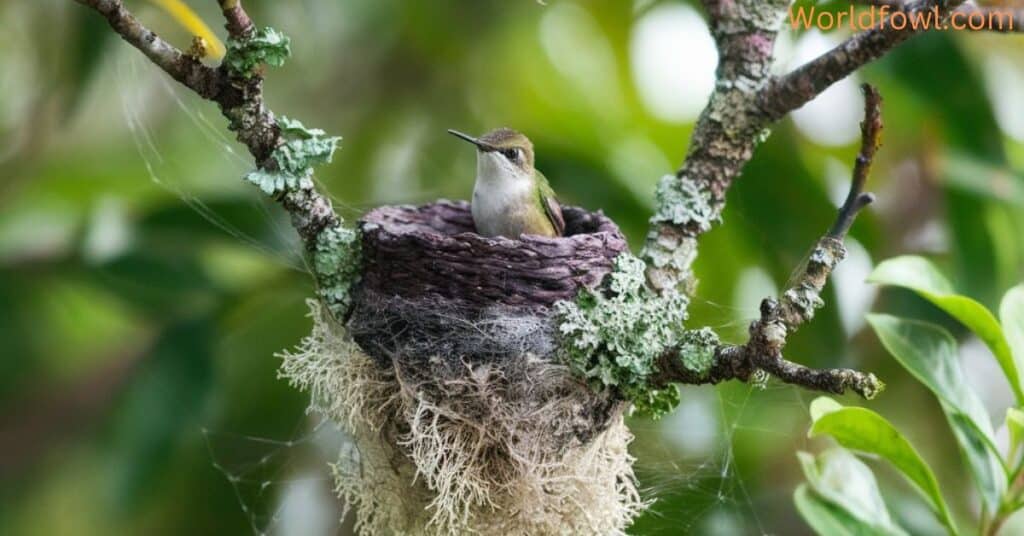
In many countries, including the United States, it’s illegal to remove active hummingbird nests. However, once a nest is abandoned:
- It can be legally removed if necessary
- It’s often best to leave it in place as it may be reused or provide materials for future nests
Always check local regulations before interfering with any bird nests.
How to ethically observe and protect hummingbird nests
If you’re lucky enough to spot a hummingbird nest, follow these guidelines:
- Keep your distance to avoid disturbing the birds
- Use binoculars for closer observation
- Never touch or move the nest
- Avoid using pesticides in the area
- Keep pets away from nesting sites
Creating hummingbird-friendly environments in your backyard
You can support hummingbird nesting by:
- Planting native, nectar-producing flowers
- Providing a water source like a mister or shallow fountain
- Avoiding the use of pesticides
- Leaving spider webs intact (they’re a source of nesting material)
- Installing hummingbird feeders to supplement natural food sources
Fascinating Facts About Hummingbird Nests
The world of hummingbird nests is full of surprises. Here are some intriguing facts that showcase the remarkable nature of these tiny structures.
Record-breaking nest sizes and locations
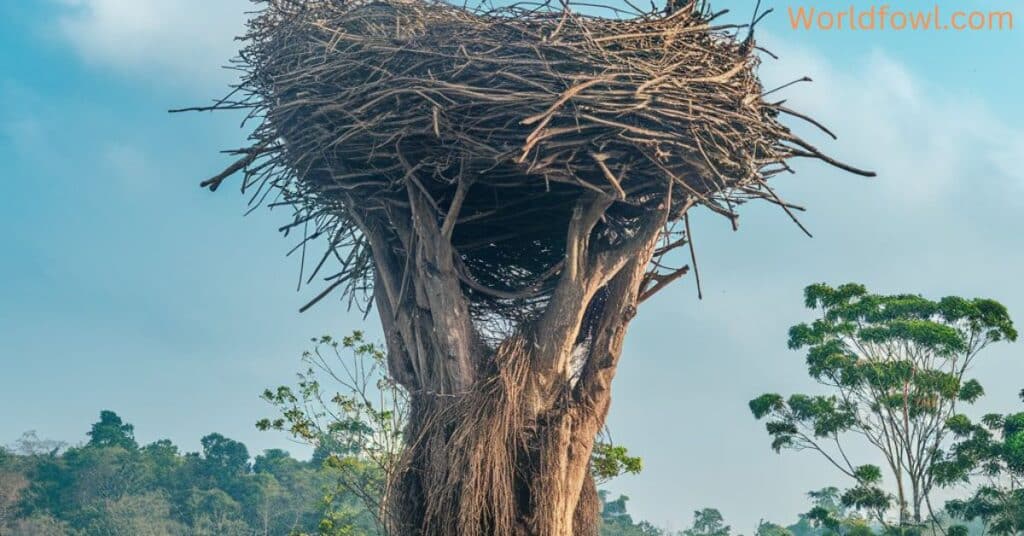
- Smallest nest: The Bee Hummingbird’s nest is about the size of a quarter
- Highest recorded nest: A Broad-tailed Hummingbird nest was found at 10,000 feet elevation in Colorado
- Most unusual location: Nests have been found on wind chimes, clotheslines, and even on top of cactus spines
Unusual materials found in hummingbird nests
While spider silk and plant down are common, some unusual materials have been observed in hummingbird nests:
- Human hair
- Bits of paper
- Fragments of snakeskin
- Artificial fibers from outdoor furniture
How climate change might affect nesting behavior
Climate change poses several challenges to hummingbird nesting:
- Timing mismatches: Earlier spring temperatures may not align with flower blooming, affecting food availability during nesting
- Extreme weather events: More frequent storms can damage nests and disrupt breeding
- Habitat shifts: Changing climate patterns may alter suitable nesting areas
- Competition: Changes in plant communities may affect the availability of nesting materials
Conclusion
The world of hummingbird nests is a testament to the ingenuity and adaptability of these remarkable birds. From the intricate construction process to the careful selection of materials and locations, every aspect of hummingbird nesting behavior is finely tuned for survival.
While hummingbirds rarely reuse nests, their annual nesting ritual is a crucial part of their life cycle. Understanding these habits not only satisfies our curiosity but also helps us better protect and support these tiny marvels of nature.
As we continue to study and admire hummingbirds, let’s remember the importance of conservation efforts. By creating hummingbird-friendly environments and respecting their nesting sites, we can ensure that future generations will continue to be enchanted by the buzz of tiny wings and the sight of jewel-like birds hovering among the flowers.
FAQs
How many eggs do hummingbirds typically lay?
Most hummingbird species lay two eggs per breeding attempt. Occasionally, a single egg might be laid, but three eggs are extremely rare.
Can hummingbirds abandon their nests?
Yes, hummingbirds may abandon their nests if:
- They’re frequently disturbed by humans or predators
- The nest is damaged
- Food sources become scarce
- Extreme weather conditions persist
How long do baby hummingbirds stay in the nest?
Baby hummingbirds typically remain in the nest for about 18-22 days before fledging. However, this can vary slightly depending on the species and environmental conditions.
Are there any hummingbird species that exhibit different nesting behaviors?
While most hummingbirds follow similar nesting patterns, some variations exist:
- The Pygmy Hermit builds a cone-shaped nest suspended from a single palm leaf
- The White-whiskered Hermit sometimes adds a ‘tail’ to its nest for better balance
How can I attract nesting hummingbirds to my garden?
To attract nesting hummingbirds, try these strategies:
- Plant native, nectar-rich flowers
- Provide a water source like a mister or shallow fountain
- Leave out bits of cotton or other soft materials for nest building
- Maintain a pesticide-free garden
- Install hummingbird feeders as a supplementary food source
Remember, creating a hummingbird-friendly environment is about more than just attracting them—it’s about supporting their entire life cycle, including their fascinating nesting habits.

Henry James is a seasoned blogger and a passionate storyteller on “World Fowl.” With years of experience crafting engaging content, he brings a unique blend of expertise and creativity to his writing. Henry specializes in exploring diverse topics with depth and clarity, captivating readers worldwide.

